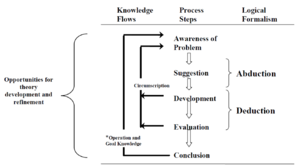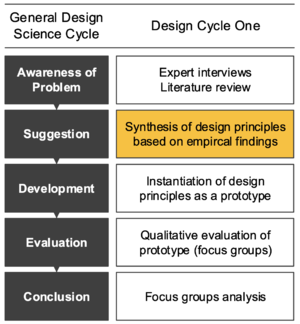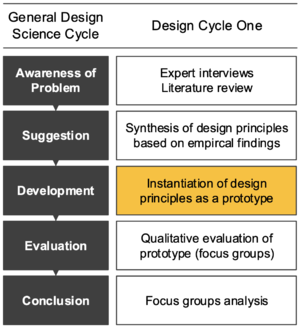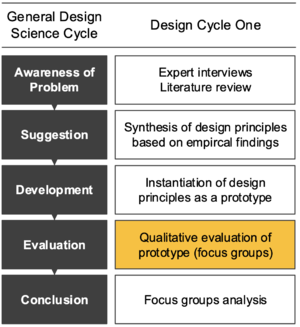Design Science Research according to Kuechler & Vaishnavi
Introduction
"Two paradigms characterize much of the research in the Information Systems discipline: behavioral science and design science. The behavioral science paradigm seeks to develop and verify theories that explain or predict human or organizational behavior. The design-science paradigm seeks to extend the boundaries of human and organizational capabilities by creating new and innovative artifacts. Both paradigms are foundational to the IS discipline, positioned as it is at the confluence of people, organizations, and technology." (Hevner et. al.) [1]
In many publications, essays, editorials or books describing the Design Science Research (DSR) method the authors aim to support researchers to conduct DSR projects for example by providing guidelines [2] [3] or how to extend on existing design knowledge [4] and many more. Gregor and Hevner provide foundational guidance by describing their understanding and application of DSR concepts and providing guidance for researches on how to:
- Appreciate the levels of artifact abstractions that may be DSR contributions
- Identify appropriate ways of consuming and producing knowledge when you are preparing journal articles or other scholarly works
- Understand and position the knowledge contributions of your research projects
- Structure a DSR article so that it emphasizes significant contributions to the knowledge base
Their focal contribution is the DSR knowledge contribution framework with two dimensions based on the existing state of knowledge in both the problem and solution domains for the research opportunity under study. In addition, they propose a DSR communication schema with similarities to more conventional publication patterns, but which substitutes the description of the DSR artifact in place of a traditional results section. [5]
Other researchers propose a set of core dimensions of a Design Science Research project that facilitates effective capture of the most relevant aspects of a DSR project to efficiently plan and communicate key considerations and conceptualizations of a DSR project. In this work, the authors represent six dimensions in the form of a DSR grid, a one-page visualization of the DSR project that is adjustable to the specific purpose for using the concept. [6]
Another important role in DSR is how to specify design theory so that it can be communicated, justified, and developed cumulatively. In the essay of Gregor and Jones they focus on the structural components or anatomy of design theories in IS [7] . Baskerville and Pries-Heje focus on how design theories are explanatory. In their work, they demonstrate that design theories deliver functional explanations with a simple and elegant structure explaining generalized solution components by the related generalized requirements [8] .
In the book, Design Science Research Cases [9] several DSR cases are presented by experienced researchers in the field. It offers readers access to real-world DSR studies, together with the authors’ reflections on their research processes. The description of the cases supports researchers in addition to existing introductions to DSR methods and processes.
Process description
This process describes the Design Science Research process according to Kuechler & Vaishnavi.This model is an adaptation of a computable design process model developed by Takeda, et al. (1990) [10] . Even though the different phases in a design process and a design science research process are similar, the activities carried out within these phases are considerably different. Also, what makes the design science research process model different from the corresponding design process model is the fact that contribution of new (and true) knowledge needs to be a key focus of design science research. [11]
Awareness of Problem
Description
Describe the awareness of an interesting problem. Awareness can come from new developments in the industry or from other reference disciplines.
Examples
Expert interviews with eight employees of the case company revealed:
- Lack of process (model) understanding Difficulties in execution business processes
- Structured literature review on the concept “guidance” in IS research
Structured literature review on the concept “guidance” in IS research:
- Overview on existing research (Literature Review according to vom Brocke et al. or Literature Review according to Webster and Watson)
- Taxonomy of guidance in IS research (Taxonomy development)
Further Readings
Kuechler, W., & Vaishnavi, V. (2008). On theory development in design science research: Anatomy of a research project. European Journal of Information Systems, 17(5), 489–504. https://doi.org/10.1057/ejis.2008.40
Vaishnavi, V., Kuechler, W., and Petter, S. (Eds.) (2004/19). “Design Science Research in Information Systems” January 20, 2004 (created in 2004 and updated until 2015 by Vaishnavi, V. and Kuechler, W.); last updated (by Vaishnavi, V. and Petter, S.), June 30, 2019. URL: http://www.desrist.org/design-research-in-information-systems/.
Suggestion
Description
Synthesis of design principles based on empirical findings:
- Extraction of Meta-Requirements from existing literature.
- Derivation of Design Principles based on the Meta- Requirements.
- Selection of Design Decisions to implement the Design Principles.
Examples
Further Readings
Kuechler, W., & Vaishnavi, V. (2008). On theory development in design science research: Anatomy of a research project. European Journal of Information Systems, 17(5), 489–504. https://doi.org/10.1057/ejis.2008.40
Vaishnavi, V., Kuechler, W., and Petter, S. (Eds.) (2004/19). “Design Science Research in Information Systems” January 20, 2004 (created in 2004 and updated until 2015 by Vaishnavi, V. and Kuechler, W.); last updated (by Vaishnavi, V. and Petter, S.), June 30, 2019. URL: http://www.desrist.org/design-research-in-information-systems/.
Gregor, S., Chandra Kruse, L., & Seidel, S. (in press). The Anatomy of a Design Principle.Journal of the Association for Information Systems.
Chandra Kruse, L. and Nickerson, J. V. (2018), Portraying Design Essence (January 2018). Paper presented at the 51st Hawaii International Conference in System Science (HICSS)
Gregor, S., Chandra Kruse, L., & Seidel, S. (in press). The Anatomy of a Design Principle. Journal of the Association for Information Systems.
Development
Description
Implement the suggested design. Different techniques can be used depending on the artifact to be constructed.
Examples
Instantiation of design principles as a prototype
Further Readings
Kuechler, W., & Vaishnavi, V. (2008). On theory development in design science research: Anatomy of a research project. European Journal of Information Systems, 17(5), 489–504. https://doi.org/10.1057/ejis.2008.40
Vaishnavi, V., Kuechler, W., and Petter, S. (Eds.) (2004/19). “Design Science Research in Information Systems” January 20, 2004 (created in 2004 and updated until 2015 by Vaishnavi, V. and Kuechler, W.); last updated (by Vaishnavi, V. and Petter, S.), June 30, 2019. URL: http://www.desrist.org/design-research-in-information-systems/.
Evaluation
Description
Evaluate the artifact according to criteria that are made in the 'Awareness of Problem' activity.
Examples
Qualitative evaluation of the prototype by eg. focus group workshops in the case company:
- SWOT analysis
- Feedback by the participants
Further Readings
Evaluation Patterns for Design Science Research Artefacts
Kuechler, W., & Vaishnavi, V. (2008). On theory development in design science research: Anatomy of a research project. European Journal of Information Systems, 17(5), 489–504. https://doi.org/10.1057/ejis.2008.40
Vaishnavi, V., Kuechler, W., and Petter, S. (Eds.) (2004/19). “Design Science Research in Information Systems” January 20, 2004 (created in 2004 and updated until 2015 by Vaishnavi, V. and Kuechler, W.); last updated (by Vaishnavi, V. and Petter, S.), June 30, 2019. URL: http://www.desrist.org/design-research-in-information-systems/.
Conclusion
Description
Write up the results and explain the gained knowledge. Learnings can be described as 'firm' facts that can be:
- repeatably applied
- repeatably invoked
Or there are findings that may serve as the subject of further research.
Examples
Further Readings
Kuechler, W., & Vaishnavi, V. (2008). On theory development in design science research: Anatomy of a research project. European Journal of Information Systems, 17(5), 489–504. https://doi.org/10.1057/ejis.2008.40
Vaishnavi, V., Kuechler, W., and Petter, S. (Eds.) (2004/19). “Design Science Research in Information Systems” January 20, 2004 (created in 2004 and updated until 2015 by Vaishnavi, V. and Kuechler, W.); last updated (by Vaishnavi, V. and Petter, S.), June 30, 2019. URL: http://www.desrist.org/design-research-in-information-systems/.
References
- ↑ Hevner AR, March ST, Park J and Ram S (2004) Design Science in Information Systems Research. MIS Quarterly 28(1), 75-105.
- ↑ Hevner AR, March ST, Park J and Ram S (2004) Design Science in Information Systems Research. MIS Quarterly 28(1), 75-105.
- ↑ van der Merwe A., Gerber A., Smuts H. (2020) Guidelines for Conducting Design Science Research in Information Systems. In: Tait B., Kroeze J., Gruner S. (eds) ICT Education. SACLA 2019. Communications in Computer and Information Science, vol 1136. Springer, Cham. https://doi.org/10.1007/978-3-030-35629-3_11
- ↑ vom Brocke, J., Winter, R., Hevner, A., Maedche, A. (2020), Accumulation and Evolution of Design Knowledge in Design Science Research – A Journey Through Time and Space, in: Journals of the Association for Information Systems (JAIS), 2020, forthcoming (ABDC_2016: A*; ABS: 4; ISI: 3.487; ISI: 2.109; VHB_3: A).
- ↑ Gregor S and Hevner AR (2013) Positioning and Presenting Design Science Research for Maximum Impact. MIS Quarterly 37(2), 337-55.
- ↑ vom Brocke, J., Maedche, A. (2019), The DSR Grid: Six Core Dimensions for Effectively Planning and Communicating Design Science Research Projects, in: Electronic Markets, Volume 29, Issue 3, pp 379–385 (ABDC: A; ABS: 2; ISI: 2.121; VHB: B).
- ↑ Gregor S and Jones D (2007) The Anatomy of a Design Theory. Journal Of The Association For Information Systems 8(5), 312-335.
- ↑ Baskerville, R.; Pries-Heje, J.: Explanatory Design Theory, in: Business & Information Systems Engineering, 2, 5, 2010, pp. 271-282.
- ↑ Brocke, J. vom, Hevner, A., and Mädche, A. (eds.). 2020. Design Science Research. Cases, Progress in IS, Springer International Publishing. https://doi.org/10.1007/978-3-030-46781-4.
- ↑ Takeda, H., Veerkamp, P., Tomiyama, T., and Yoshikawam, H. (1990). “Modeling Design Processes.” AI Magazine Winter: 37–48.
- ↑ Vaishnavi, Vijay & Kuechler, B. (2004). Design Science Research in Information Systems. Association for Information Systems.



